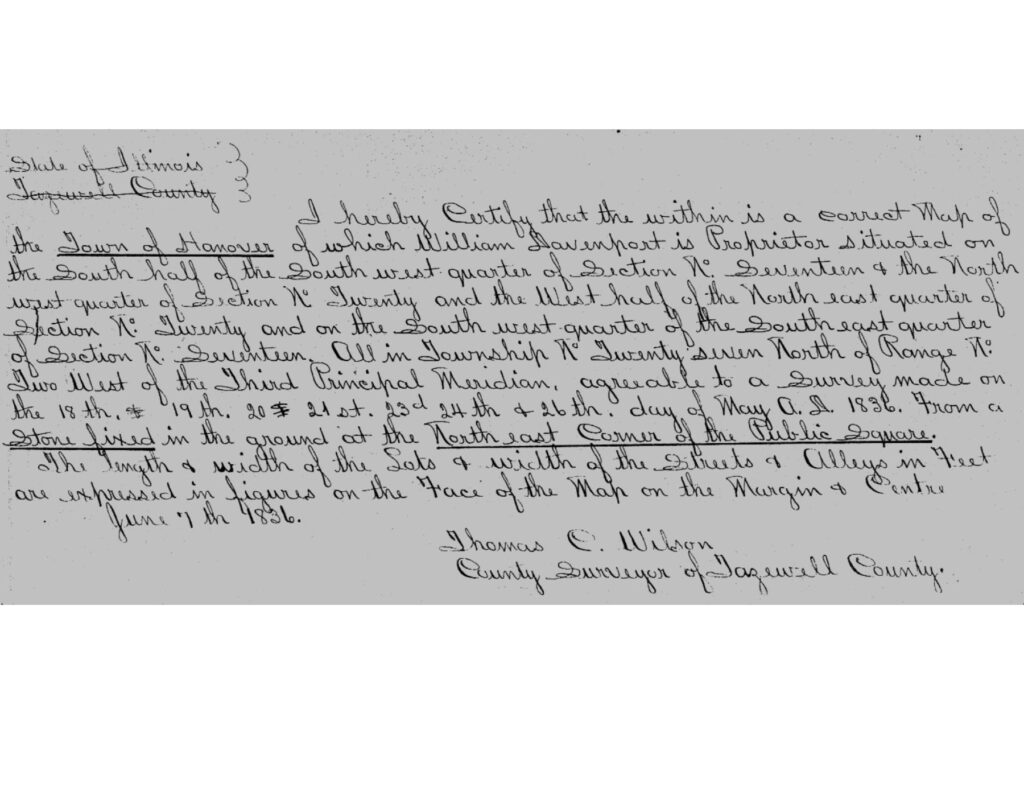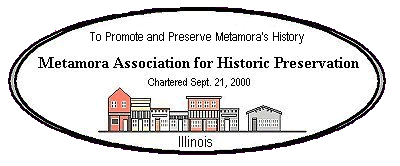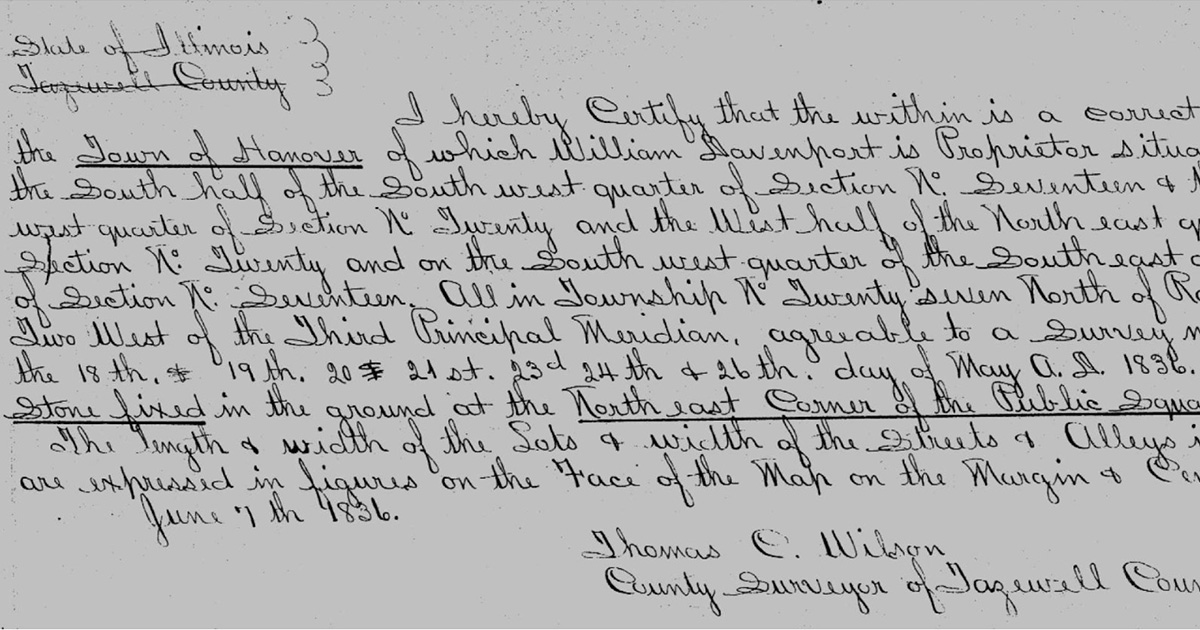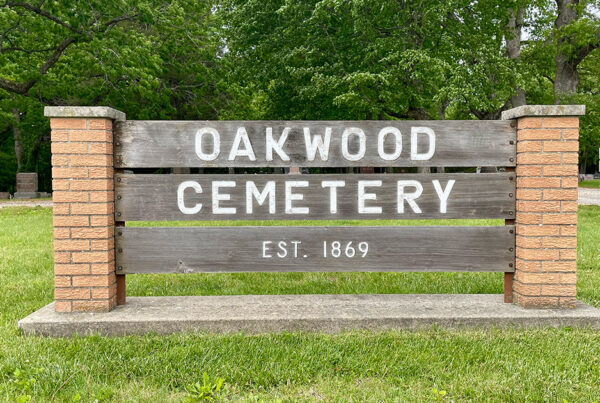Metamora, Illinois
Woodford County
Metamora Township
Township 27 North
Range 2 West of the 3rd Principal Meridian
Elevation 814 feet above sea level

From the Metamora Sentinel dated February 10, 1898
Metamora, formerly the County seat of Woodford County, (and should be now) is situated almost in the center of the county 18 miles northeast of Peoria. The present town site was settled in 1842, the natural advantages of Metamora by not surpassed by any town in the state and her enterprising citizens have not been in those advantages in a place to make Metamora one of the most beautiful and desirable locations in the great state. Metamora is located on a high dry and gently undulating plain thus insuring perfect natural drainage while at the same time it is rich and productive giving every citizen the opportunity to have his own private garden of beautiful flowers, delicious small fruits and vegetables. We have the most beautiful park in the state outside of Chicago. In all well regulated communities where education, intelligence and good morals predominate the “Art Preservation” always flourishes and this fact finds especial emphasis in Metamora where one good paper is published and well patronized by the public citizens. There are three good churches here, namely, Catholic, Union and German Lutheran, also a large Orphan’s Home in charge of Sisters of Charity and is one of the grandest and most ably managed institutions in the state. Metamora has a public school of which to be proud. The school building is a large two story brick structure comfortably seated and furnished with all modern appliances. The school which has an enrollment of two hundred pupils is classified into twelve grades and has been for several years under the management of Prof. Begardus, an experienced educator, assisted by three efficient teachers. People from the county or from a distance who wish to move to town to educate their children will find that Metamora’s Graded School stands in the rank as an educational institution. The principle general merchants are Conrad & Son, C. Rohman and X. Knoblauch. In drugs and groceries we have A. H. Wilson and Chas. Bachman both genial up to date gentlemen; in hardware there is Mr. Bride and Mr. Wiltz both carrying complete stocks at right prices; our grain buyers are Andrews and Heintz, the latter also deals in coal and lumber; barbers are Joe Heininger and Mr. Frantz both as fine as “they make ‘em”; our physicians are Dr. Heintzman and Dr. Joe Knoblauch both skilled in their profession; the hotels are the Carpenter House owned and managed by James Hall and the Metamora House owned and managed by Thomas Spears. We have only one meat market owned and run by Joe Theena which is a marvel of neatness; our furniture house is run by Mr. Jacquat and is first class. Liquors and refreshments are dispensed by Victor Ioerger, Schrepfer and John B. Knoblauch, all genial gentlemen; as to veterinary we have Dr. Chas. Heininger, a graduate of Chicago College who will attend promptly to calls from a distance. Dentistry, Dr. J.P. Harvey, is our only advertiser in this line, read his card and then give him your patronage. We also have a new bakery and it is a marvel of neatness and excellence, in short we have the best town on earth to live in and transact business, our people are models of virtue, honesty and sobriety, anyone seeking a place for residence or business can do no better.
The following article was written by Madeline Sullivan who had a great interest in Metamora History:
Metamora was originally called Hanover. Someone must have known an old Indian chief by the name of “Metamora”. It was just a small collection of people practically dumped out on the fertile prairie. The early settlers were New England people. The Page Family Adino-True and John Page were early settlers. They came from one of the eastern states. M. Adino Page was a school mate of John Greenleaf Whittier, the poet (Quaker) who wrote “Snowbound” and which we school children had to learn. I don’t know whether they do now or not. We had the Page family to thank for the town library. It was one of the best. Upon its shelves were all standard books by the best of writers and what is more those books were read. I have a few from the old library for when the library closed the books were divided. It cost $1.00 a year to belong. There were two inns. The old Metamora House and the American House. In the old Metamora House, presided over by Mrs. Spires gathered during the weeks of court such as made history. There was A. Lincoln, Stephen Douglas, Judge David Davis, Judge Puterbaugh, Judge Shaw, Adlai Stevenson who was later Vice President of the United States, Dr. Johns, Robert Ingersol and many others whose names escape me for the moment. One can imagine the conversation and the fun those men had when the court docket lasted weeks. Mr. Ingersol immortalized the Metamora House in the first book he wrote on his return from England. He said the draperies of Winsor Castle reminded him of the tablecloth in the Metamora House in the 3rd week of court. “What wasn’t coffee was egg and what wasn’t egg was coffee”.
Later Mrs. Dr. Zacharis Whitmire entertained these gentlemen and many good stories she told of their gatherings. Then there were many lesser lights in the legal profession who were residents of Metamora. A Mr. Kipp, Judge Malcome P. Brown whose wife had a small museum, Robert Cassell, Albert Rich, John Ray J . Perry and many others. Then there were Doctors James Whitmire and his brother Dr. Zach Whitmire. Dr. James Whitmire was at one time the president of the state Medical Society. He was a Civil War Physician and Surgeon and drove about in a two wheeled gig drawn by an Indian pony. The postmaster, Mr. Delph was the only government official in town and when news of battles of the Civil War came he mounted a box just outside the post office and read it to the assembled crowd who came to hear the news.
The beautiful park in the center of town which was called “the square” was laid out and planted by Dr. Joseph Clark, a graduate of Darthmouth College. The Court House was built by David Irving.
When the Civil War broke out, the town was about evenly divided, some sympathized with the south and some with the north and it bid fare to tear the social order to pieces. It was then that wisdom prevailed and the Good Fellow Society was organized. They were to meet and debate the issues of the day. They went at it hammer and tongs and often the light had to be extinguished to allow the canbatants to cool off but the rule was that when the meeting was over they should all be friends again. Some of the runaway slaves were conducted to freedom by the Morse family and their place was one of the chain of the underground railroad.
Mr. George Harl was the editor of the Metamora Sentinel. During the Civil War and from the square he marched away the men who went to war and some never came back. Mr. Adlai Stevenson married a southern girl who brought her negro servants when she came to live in Metamoa. A small brick house was built back of the square house. It was there the negroes lived. Up to that time we had not seen a colored person. The Stevenson house was built by George Lemon and is still standing.
The Court House which is now a state memorial was the hub of the wheel and about it centered the interest of the town. There was no means of transportation except horseback and buggies. Thru the influeance of Mr. Isaac Wikoff and others, the Chicago and Alton Railroad laid the first railroad track.
The day that the construction crew reached Metamora was celebrated by a barbecue. People came from the country and brought their picnic dinner with them. It was a day of rejoicing when the first engine puffed thru town.
The first school house burned down but classes were held in various churches. In 1870 the present structure was built. Up to that time the school was not graded. Some of the teachers were Misses Suna and Ella Painter who took their classes to fractions and when the school opened in the fall, we began again at the first of the book and again our knowledge of arithmetic ended with fractions but one day Albert Evans, a Normal graduate became the principal and he changed the order of things and we proceeded through the book. James Kirk and Hale Morse were also principals. In the early days Prof. Dan Pedro Taft, the father of Mr. Lorado Taft, the world renown sculpture, was at the head of our school. When I went to school the rod was still in use and when Mr. Reedy whipped a boy we girls would wrap our aprons around our heads so as not to hear the boys outcry. I know now the louder he cried the less the punishment.
I helped to grade the school under Hale Morse. We knew little about microbes for it was a privilege granted to carry the water bucket up and down the aisle and all drink from the common dipper.
Very few of the teachers had special training for the job. If they could answer the questions on the examination papers they received a certificate to teach. After many years of study and reading I still know so little. I often think what I could have taught those children then.
One of the notable events in Metamora was the organization of the Christian Union Church. The Methodist, Baptist, Congregational, Episcopalian and Christian Churches all had small box like churches. But a time came when each congregation was too small to pay a minister. Mr. Isaac Wikoff brought the representations of each denomination together. They all felt the need of the influence of the church for themselves and their children was the only way to have it was to join together. That was a great step in advance for 65 years as such a thing as a Union of denominations was unheard of. It was the first Christian Union in the United States. Since, it has weathered all these years. It still exists and I am proud to tell of it.




